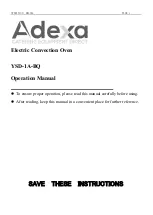
I
NSTALLATION
C
OMBINATION
O
VEN
P
AGE
12
O
PERATOR
’
S
M
ANUAL
1180963
IN
S
TA
LLA
TI
ON
Step 7: Gas Connection
If this equipment is being installed at over 2,000 feet altitude and that information was not specified when
ordered, contact the appropriate authorized Southbend Service Representative or the Southbend Service
Department. Failure to install with proper orifice sizing will result in poor performance and may void the
warranty.
The serial plate is located behind the lower front panel on the left side. It indicates the type of gas the unit is
equipped to burn. All Southbend equipment is adjusted at the factory. Check type of gas on serial plate.
This appliance should be connected ONLY to the type of gas for which it is equipped.
A 3/4" male NPT line is provided at the rear for the connection. Each oven is equipped with an internal
pressure regulator which is set for 4" W.C. manifold pressure for natural gas or 10.0" W.C. manifold pressure
for propane gas. Use the 1/8" tap on the top of the gas valve for checking pressure.
If applicable, the vent line from the gas appliance pressure regulator shall be installed to the outdoors in
accordance with local codes or, in the absence of local codes, with the
National Fuel Gas Code, ANSI
Z223.1
,
Natural Gas Installation Code, CAN/CGA-B149.1
, or
the Propane Installation Code, CAN/CGA-
B149.2
, as applicable.
An adequate gas supply is imperative. Undersized or low pressure lines will restrict the volume of gas
required for satisfactory performance. Fluctuations of more than 25% on natural gas or 10% on propane gas
will create problems and affect burner operating characteristics. A 1/8” pressure tap is located on the gas
valve to measure the manifold pressure.
An adequate gas supply line to the unit should be no smaller than the I.D. of the pipe from the unit to which it
is connected.
Purge the supply line to clean out dust, dirt, or other foreign matter before connecting the line to the unit.
Each oven has a manual shut off valve located behind the lower front panel.
Use pipe joint compound which is suitable for use with LP gas on all threaded connections.
!
CAUTION
ALL PIPE JOINTS AND CONNECTIONS MUST BE TESTED THOROUGHLY FOR GAS LEAKS.
USE ONLY SOAPY WATER FOR TESTING ON ALL GASES. NEVER USE AN OPEN FLAME TO
CHECK FOR GAS LEAKS. ALL CONNECTIONS MUST BE CHECKED FOR LEAKS AFTER THE
UNIT HAS BEEN PUT INTO OPERATION. TEST PRESSURE SHOULD NOT EXCEED 14” W.C.













































